Silvicultural Effects on Environmental Conditions and Resulting Aboveground Productivity and Carbon Sequestration of Northeastern Mixedwood Forests

Early successional forests comprise nearly 12% of forestland in Maine, yet their response to silvicultural treatments is poorly understood. To better understand mechanisms driving silvicultural responses and forest productivity, NSRC researchers quantified sunlight capture and use efficiency by tree leaves on the Penobscot Experimental Forest. The study area consisted of stands of different species composition (hardwood-dominated, conifer-dominated, mixedwood) and silvicultural treatment.
In developing leaf area models for early successional tree species (birch, poplar, red maple) researchers found that species differed considerably in amount of leaf area produced and how leaf area was partitioned within tree crowns. They linked these models with inventory data to examine changes over time in stand leaf area in response to contrasting silvicultural treatments. Although leaf area was reduced considerably in all treatments, it approached pre-treatment values 7 years after treatment but shifted to different species groups. Leaf area in conifer-dominated and mixedwood stands shifted to conifers and shade tolerant hardwoods, while leaf area in hardwood-dominated treatments remained in shade intolerant hardwoods. Treatments also affected vertical partitioning of leaf area in the canopy, with most rapid upward partitioning in shade intolerant hardwoods. In contrast, conifer species allocated leaf area laterally even after release.
Researchers explored how contrasting growing conditions (plantations vs. natural stands) affected light capture and use by white spruce. Average-sized spruces in plantations, with less competition from other trees, absorb substantially more light than spruces in natural stands. In comparison, the efficiency that captured light was converted to aboveground biomass was greater in natural stands, likely due to white spruce’s moderate shade tolerance.
